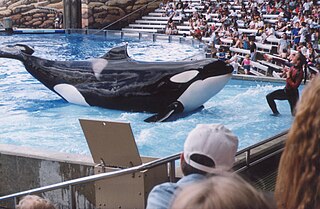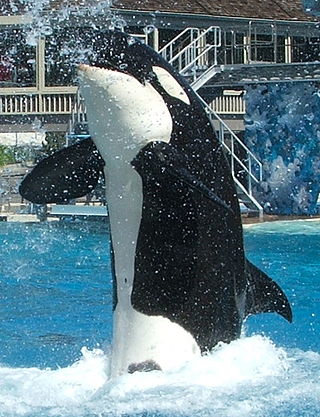
Corky II, often referred to as just Corky, is a female captive orca from the A5 Pod of northern resident orcas. At approximately the age of four, Corky was captured from Pender Harbour off the coast of British Columbia on 11 December 1969. She has lived at SeaWorld San Diego in San Diego, California since 21 January 1987. As of 2024, she is the oldest and longest kept captive orca. SeaWorld San Diego celebrates her birthday on 1st January every year.

Katina is a female orca who lives at SeaWorld Orlando in Florida. She was captured off Iceland at approximately three years of age on 26 October 1978. She is the most successful breeding female orca in captivity. SeaWorld Orlando celebrates her birthday on 1 June every year.
Orcas are large, powerful aquatic apex predators. There have been incidents where orcas were perceived to attack humans in the wild, but such attacks are less common than those by captive orcas. In captivity, there have been several non-fatal and four fatal attacks on humans since the 1970s. Experts are divided as to whether the injuries and deaths were accidental or deliberate attempts to cause harm.

Springer, officially named A73, is a wild orca from the Northern Resident Community of orcas, which frequents the waters off the northern part of Vancouver Island every summer. In January 2002, Springer, then a calf developmentally equivalent to a human toddler, was discovered alone and emaciated some 250 miles from the territory of her family. Experts identified Springer by her vocal calls that are specific to her family, or "pod," and by examining photographs of her eye patch. They were also able to determine where Springer's pod was currently located.
Samoa was a female killer whale captured in November 1983 in Iceland. She was captured off the east coast near Berufjordur and was sent to Saedyrasafnid aquarium before she was sold to Acuarama, a Brazilian aquarium along with a male named Nandu.

Dozens of orcas are held in captivity for breeding or performance purposes. The practice of capturing and displaying orcas in exhibitions began in the 1960s, and they soon became popular attractions at public aquariums and aquatic theme parks due to their intelligence, trainability, striking appearance, playfulness, and sheer size. As of 24 March 2024, around 55 orcas are in captivity worldwide, 33 of which were captive-born. At that time, there were 18 orcas in the SeaWorld parks.

Michael Andrew Bigg was an English-born Canadian marine biologist who is recognized as the founder of modern research on killer whales. With his colleagues, he developed new techniques for studying killer whales and, off British Columbia and Washington, conducted the first population census of the animals anywhere in the world. Bigg's work in wildlife photo-identification enabled the longitudinal study of individual killer whales, their travel patterns, and their social relationships in the wild, and revolutionized the study of cetaceans.
Captured in 1964, Moby Doll was the first orca to survive in captivity for more than two days, and the second to be displayed in a public aquarium exhibit. The availability, for the first time, of an orca that could be studied at close quarters alive initiated pioneering research. From a recording of Moby Doll's calls, he was years later identified as a member of J Pod of the southern resident orcas.
Edward Irving "Ted" Griffin is an American former aquarium owner and entrepreneur who was the first man to ever swim with a killer whale in a public exhibition, with the whale named Namu. He is best known for capturing, performing with, and selling a number of orcas during the late 1960s and early 1970s.

Dawn Therese Brancheau was an American animal trainer at SeaWorld. She worked with orcas at SeaWorld Orlando for fifteen years, including a leading role in revamping the Shamu show, and was SeaWorld's poster girl. She was killed by an orca, Tilikum, who was also involved in the deaths of Keltie Byrne and Daniel P. Dukes.

Tilikum, nicknamed Tilly, was a captive male orca who spent most of his life at SeaWorld Orlando in Florida. He was captured in Iceland in 1983; about a year later, he was transferred to Sealand of the Pacific near Victoria, British Columbia, Canada. He was subsequently transferred in 1992 to SeaWorld in Orlando, Florida, where he sired 21 calves throughout his life.

Shamu was the stage name used for several performing orcas at SeaWorld
Chimo was a young female orca exhibited in Sealand of the Pacific at The Oak Bay Marina in The Municipality of Oak Bay, British Columbia, Canada near the city of Victoria from 1970 to 1972. Chimo was notable for being the only partially albino orca ever exhibited in captivity. Chimo was captured in an effort to find a mate for the park's star attraction, Haida. After her capture, Sealand became famous. Chimo's probable mother was another orca by the name of Scarredjaw Cow (T3), captured along with Chimo. Chimo died in 1972 from complications caused by Chédiak–Higashi syndrome, the syndrome which caused her albinism. Chimo never bore any calves.

The Oak Bay Marina is located in South Oak Bay, adjacent to the city of Victoria, British Columbia, Canada. Built on Turkey Head Point, the Oak Bay Marina is operated by The Oak Bay Marine Group. It is home to a fuel dock, gift shop, coffee shop and restaurant as well as some private and community organisations: C-Tow Victoria, Gartside Marine boat repairs, Vela Yacht Sales, Oak Bay Sailing School, 12th Garry Oak Sea Scouts, Oak Bay Sea Rescue RCM-SAR Station #33, and the Oak Bay Recreation sailing program.

Tilikum v. Sea World was a legal case heard in the US Federal Court in 2012 concerning the constitutional standing of an orca. It was brought by People for the Ethical Treatment of Animals (PETA) on behalf of Tilikum, an orca kept in the SeaWorld Orlando park, against the SeaWorld corporation.
The Yukon Harbor orca capture operation was the first planned, deliberate trapping of a large group of orcas. 15 southern resident orcas were trapped by Ted Griffin and his Seattle Public Aquarium party on 15 February 1967, in Yukon Harbor on the west side of Puget Sound. The first four orcas that had been taken into captivity had been captured singly, and mostly opportunistically. Those four were named Wanda, Moby Doll, Namu, and Shamu—who was then the only surviving one. Through them, interest in orcas had escalated.

The waters of the Salish Sea, on the west coast of North America, are home to several ecologically distinct populations of orcas. The area supports three major ecotypes of orcas: northern residents, southern residents, and transients. A fourth ecotype, the offshore orcas, occasionally venture into nearshore waters. Little to no interaction occurs between the different ecotypes. Resident and transient orcas have not been observed interbreeding, although occasional brief interactions occur.










